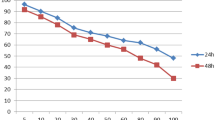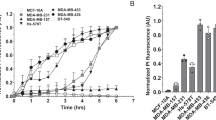Abstract
Ribosomal synthesized antimicrobial peptides (AMPs) are widely distributed in nature and are toxic to certain microorganisms. Some of these AMPs are found to exhibit cytotoxic activity against the growth of cancer cells and thus have obvious anticancer potential. Here, we have studied the antiproliferation on the human colorectal cancer cell line SW480 of two AMPs, namely m2163 and m2386, identified by us from a lactic acid bacterium Lactobacillus casei ATCC 334 previously. A half maximal inhibitory concentration (IC50) of 40 μg/ml is determined first using the MTT (3-(4, 5-cimethylthiazol-2-yl)-2,5-diphenyl tetrazolium bromide) assay for either peptide m2163 or m2386. The apoptosis in treated SW480 cells by either peptide m2163 or m2386 is analyzed using flow cytometry with annexin V-fluorescein isothiocyanate (FITC) and propidium iodide double staining. These analyses show that a substantial population of treated SW480 cells can undergo apoptosis by either peptide m2163 or m2386. The real-time quantitative polymerase chain reaction (qPCR) and Western blot analyses are subsequently used to study how the apoptosis is induced in the treated SW480 cells by either peptide m2163 or m2386. While m2163 is found to induce the expression of Fas and TRAILR1, the expression of Fas, TNFR1, and TRAILR1 death receptors on the cell surface of treated SW480 cells is found to be induced by m2386. Further, the expression of some mitochondria-related apoptosis proteins such as Smac is found to be also induced, suggesting that either peptide m2163 or m2386 can trigger both the extrinsic and intrinsic apoptosis pathways. The cell membrane permeability is greatly enhanced upon treatment with either peptide m2163 or m2386 as analyzed by the flow cytometry using both FITC-labeled peptides. The flow cytometry is also used to analyze the fluorescence intensity given by FITC-m2163 in either the mitochondria or cytoplasm fraction of the treated and fractionated SW480 cells. It is found that the detected fluorescence intensity of the mitochondria fraction is much weaker than that of the cytoplasm one, suggesting that most of the FITC-m2163 peptides are located in the cytoplasm rather than the mitochondria. This is further confirmed by a confocal microscopy study that either peptide m2163 or m2386 can localize on the cell membrane for a substantial length of time and then penetrate into the cell cytoplasm to induce the apoptosis.








Similar content being viewed by others
References
NissenMeyer J, Nes IF. Ribosomally synthesized antimicrobial peptides: their function, structure, biogenesis, and mechanism of action. Arch Microbiol. 1997;167:67–77.
Nes IF, Yoon SS, Diep DB. Ribosomally synthesiszed antimicrobial peptides (bacteriocins) in lactic acid bacteria: a review. Food Sci Biotechnol. 2007;16:675–90.
Chen HM, Wang W, Smith D, Chan SC. Effects of the anti-bacterial peptide cecropin b and its analogs, cecropins b-1 and b-2, on liposomes, bacteria, and cancer cells. Biochim Et Biophys Acta-Gen Subj. 1997;1336:171–9.
Ye JS, Zheng XJ, Leung KW, Chen HM, Sheu FS. Induction of transient ion channel-like pores in a cancer cell by antibiotic peptide. J Biochem. 2004;136:255–9.
Cruciani RA, Barker JL, Zasloff M, Chen HC, Colamonici O. Antibiotic magainins exert cytolytic activity against transformed-cell lines through channel formation. Proc Natl Acad Sci U S A. 1991;88:3792–6.
Jacob L, Zasloff M. Potential therapeutic applications of magainins and other antimicrobial agents of animal origin. Antimicrob Peptides. 1994;186:197–216.
Lehrer RI, Lichtenstein AK, Ganz T. Defensins—antimicrobial and cytotoxic peptides of mammalian-cells. Annu Rev Immunol. 1993;11:105–28.
Lichtenstein A. Mechanism of mammalian-cell lysis mediated by peptide defensins—evidence for an initial alteration of the plasma-membrane. J Clin Invest. 1991;88:93–100.
Anderssen EL, Diep DB, Nes IF, Eijsink VGH, Nissen-Meyer J. Antagonistic activity of lactobacillus plantarum c11: two new two-peptide bacteriocins, plantaricins ef and jk, and the induction factor plantaricin a. Appl Environ Microb. 1998;64:2269–72.
Zhao H, Sood R, Jutila A, Bose S, Fimland G, Nissen-Meyer J, et al. Interaction of the antimicrobial peptide pheromone plantaricin a with model membranes: implications for a novel mechanism of action. Bba-Biomembr. 2006;1758:1461–74.
Sand SL, Haug TM, Nissen-Meyer J, Sand O. The bacterial peptide pheromone plantaricin a permeabilizes cancerous, but not normal, rat pituitary cells and differentiates between the outer and inner membrane leaflet. J Membr Biol. 2007;216:61–71.
Riley MA, Wertz JE. Bacteriocins: evolution, ecology, and application. Annu Rev Microbiol. 2002;56:117–37.
Beaulieu L, Groleau D, Legault J, Subirade M: Lactic acid bacteria-derived bacteriocin and uses thereof for prevention or treatment of cancer, Google Patents, 2006.
Cornut G, Fortin C, Soulieres D. Antineoplastic properties of bacteriocins: revisiting potential active agents. Am J Clin Oncol. 2008;31:399–404.
Hoskin DW, Ramamoorthy A. Studies on anticancer activities of antimicrobial peptides. Biochim Biophys Acta. 2008;1778:357–75.
Kanduc D, Mittelman A, Serpico R, Sinigaglia E, Sinha AA, Natale C, et al. Cell death: apoptosis versus necrosis (review). Int J Oncol. 2002;21:165–70.
Hengartner MO. The biochemistry of apoptosis. Nature. 2000;407:770–6.
Putcha GV, Harris CA, Moulder KL, Easton RM, Thompson CB, Johnson EM. Intrinsic and extrinsic pathway signaling during neuronal apoptosis: lessons from the analysis of mutant mice. J Cell Biol. 2002;157:441–53.
Goldstein JC, Waterhouse NJ, Juin P, Evan GI, Green DR. The coordinate release of cytochrome c during apoptosis is rapid, complete and kinetically invariant. Nat Cell Biol. 2000;2:156–62.
Gross A, McDonnell JM, Korsmeyer SJ. Bcl-2 family members and the mitochondria in apoptosis. Genes Dev. 1999;13:1899–911.
MacFarlane M, Williams AC. Apoptosis and disease: a life or death decision. EMBO Rep. 2004;5:674–8.
Vanlangenakker N, Vanden Berghe T, Krysko DV, Festjens N, Vandenabeele P. Molecular mechanisms and pathophysiology of necrotic cell death. Curr Mol Med. 2008;8:207–20.
Kuo YC, Liu CF, Lin JF, Li AC, Lo TC, Lin TH. Characterization of putative class ii bacteriocins identified from a non-bacteriocin-producing strain lactobacillus casei atcc 334. Appl Microbiol Biotechnol. 2013;97:237–46.
Richard C, Drider D, Elmorjani K, Marion D, Prevost H. Heterologous expression and purification of active divercin V41, a class IIa bacteriocin encoded by a synthetic gene in Escherichia coli. J Bacteriol. 2004;186:4276–84.
Huang CC, Lo CP, Chiu CY, Shyur LF. Deoxyelephantopin, a novel multifunctional agent, suppresses mammary tumour growth and lung metastasis and doubles survival time in mice. Brit J Pharmacol. 2010;159:856–71.
Huang YF, Lin YW, Lin ZH, Chang HT. Aptamer-modified gold nanoparticles for targeting breast cancer cells through light scattering. J Nanopart Res. 2009;11:775–83.
Seya K, Ono K, Fujisawa S, Okumura K, Motomura S, Furukawa K. Cytosolic Ca2+-induced apoptosis in rat cardiomyocytes via mitochondrial no-cGMP-protein kinase g pathway. J Pharmacol Exp Ther. 2013;344:77–84.
Lay MM, Karsani SA, Malek SN. 1-(2,6-dihydroxy-4-methoxyphenyl)-2-(4-hydroxyphenyl) ethanone-induced cell cycle arrest in g1/g0 in ht-29 cells human colon adenocarcinoma cells. Int J Mol Sci. 2013;15:468–83.
Mader JS, Richardson A, Salsman J, Top D, de Antueno R, Duncan R, et al. Bovine lactoferricin causes apoptosis in jurkat t-leukemia cells by sequential permeabilization of the cell membrane and targeting of mitochondria. Exp Cell Res. 2007;313:2634–50.
Leuschner C, Hansel W. Membrane disrupting lytic peptides for cancer treatments. Curr Pharm Des. 2004;10:2299–310.
Hancock REW, Sahl HG. Antimicrobial and host-defense peptides as new anti-infective therapeutic strategies. Nat Biotechnol. 2006;24:1551–7.
Wang QM, Yan B. Molecular assembly and photophysical properties of a novel luminescent terbium hybrid material with modified carboxyl group of p-aminobenzoic acid as a functional bridge. Mater Lett. 2006;60:3420–5.
Hoskin DW, Ramamoorthy A. Studies on anticancer activities of antimicrobial peptides. Bba-Biomembr. 2008;1778:357–75.
Wang KR, Yan JX, Zhang BZ, Song JJ, Jia PF, Wang R. Novel mode of action of polybia-MPI, a novel antimicrobial peptide, in multi-drug resistant leukemic cells. Cancer Lett. 2009;278:65–72.
Stennicke HR, Jurgensmeier JM, Shin H, Deveraux Q, Wolf BB, Yang XH, et al. Pro-caspase-3 is a major physiologic target of caspase-8. J Biol Chem. 1998;273:27084–90.
Li H, Zhu H, Xu CJ, Yuan J. Cleavage of BID by caspase 8 mediates the mitochondrial damage in the Fas pathway of apoptosis. Cell. 1998;94:491–501.
Nair S, Nair RRK, Srinivas P, Srinivas G, Pillai MR. Radiosensitizing effects of plumbagin in cervical cancer cells is through modulation of apoptotic pathway. Mol Carcinog. 2008;47:22–33.
Ahmad A, Banerjee S, Wang ZW, Kong DJ, Sarkar FH. Plumbagin-induced apoptosis of human breast cancer cells is mediated by inactivation of nf-kappa b and bcl-2. J Cell Biochem. 2008;105:1461–71.
Desagher S, Martinou JC. Mitochondria as the central control point of apoptosis. Trends Cell Biol. 2000;10:369–77.
Guo F, Nimmanapalli R, Paranawithana S, Wittman S, Griffin D, Bali P, et al. Ectopic overexpression of second mitochondria-derived activator of caspases (smac/diablo) or cotreatment with n-terminus of smac/diablo peptide potentiates epothilone b derivative-(bms 247550) and apo-2l/trail-induced apoptosis. Blood. 2002;99:3419–26.
Han YY, Liu HY, Han DJ, Zong XC, Zhang SQ, Chen YQ. Role of glycosylation in the anticancer activity of antibacterial peptides against breast cancer cells. Biochem Pharmacol. 2013;86:1254–62.
Pan WR, Chen PW, Chen YL, Hsu HC, Lin CC, Chen WJ. Bovine lactoferricin b induces apoptosis of human gastric cancer cell line ags by inhibition of autophagy at a late stage. J Dairy Sci. 2013;96:7511–20.
Liu S, Yang H, Wan L, Cheng JQ, Lu XF. Penetratin-mediated delivery enhances the antitumor activity of the cationic antimicrobial peptide magainin ii. Cancer Biother Radio. 2013;28:289–97.
Liu S, Yang H, Wan L, Cai HW, Li SF, Li YP, et al. Enhancement of cytotoxicity of antimicrobial peptide magainin ii in tumor cells by bombesin-targeted delivery. Acta Pharmacol Sin. 2011;32:79–88.
Tsai WH, Chang CW, Lin YS, Chuang WJ, Wu JJ, Liu CC, et al. Streptococcal pyrogenic exotoxin b-induced apoptosis in a549 cells is mediated through alpha(v)beta(3) integrin and fas. Infect Immun. 2008;76:1349–57.
Acknowledgments
This work is supported in part by grant NSC102-2313-B007-001-MY3 from the National Science Council, Taiwan ROC.
Conflicts of interest
The authors have declared that no competing interest exists.
Author information
Authors and Affiliations
Corresponding author
Rights and permissions
About this article
Cite this article
Tsai, TL., Li, AC., Chen, YC. et al. Antimicrobial peptide m2163 or m2386 identified from Lactobacillus casei ATCC 334 can trigger apoptosis in the human colorectal cancer cell line SW480. Tumor Biol. 36, 3775–3789 (2015). https://doi.org/10.1007/s13277-014-3018-2
Received:
Accepted:
Published:
Issue Date:
DOI: https://doi.org/10.1007/s13277-014-3018-2




